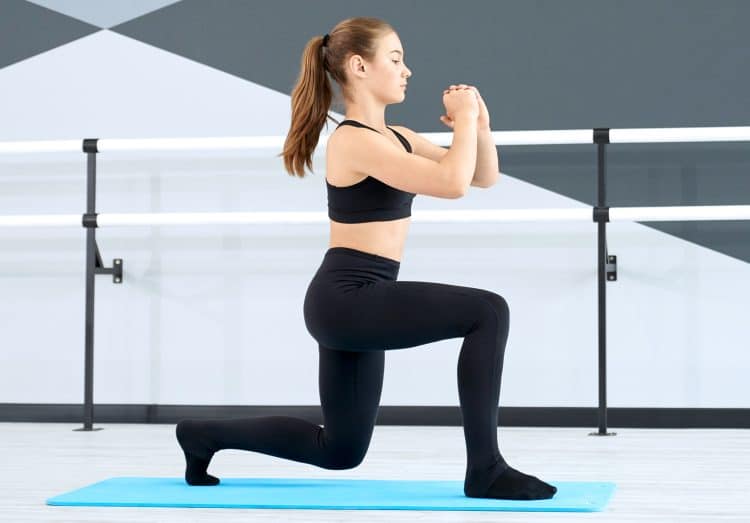Circuit training has been my go-to workout for over 30 years. It was a big part of my strength and conditioning training as a young athlete, and my first paid job in the fitness industry was as a circuit training instructor.
Now, many years later, I still use circuit training with my clients and in my own workouts. The reason for this is simple – it works.
I’ve tried lots of different training methods, but in my experience, few match the time efficiency and effectiveness of circuit training. Whether you want to get fit, burn fat, build muscle, get stronger, or improve athletic performance, circuit training can help (1).
That’s not to say that circuit training is the perfect workout. If you want to maximize muscle mass, you need to train like a bodybuilder, and dedicated cardio is best if you want to run a faster 10k.
However, suppose you want to improve multiple fitness components at the same time and develop a good level of all-around fitness. In that case, circuit training is one of your best options. That’s especially true if you only have limited time for training, e.g., 2-3 hours a week.
But is circuit training aerobic or anaerobic? And can you modify circuits to emphasize one energy system over the other? In this article, I reveal the answer.
Level Up Your Fitness: Join our 💪 strong community in Fitness Volt Newsletter. Get daily inspiration, expert-backed workouts, nutrition tips, the latest in strength sports, and the support you need to reach your goals. Subscribe for free!
Aerobic vs. Anaerobic Exercise
Your body runs on a type of chemical energy called adenosine triphosphate, or ATP for short. ATP is the energy currency of the human body, and all energy comes from this remarkable compound. Broadly speaking, there are three ways in which your body produces and uses ATP, one of which is aerobic, and two of which are anaerobic.
The Aerobic System
The aerobic system produces ATP from a combination of carbohydrates and fats in an oxygen-rich environment, i.e., during low to moderate-intensity activities. ATP is produced relatively slowly and with no significant by-products other than water, carbon dioxide, and heat.
You use more fat at lower intensity levels and more carbs when you work at a higher level of intensity. However, the aerobic system always uses a mixture of carbohydrates and fats.
Aerobic activities emphasize your type I muscle fibers, also known as slow twitch muscle fibers. These fibers have excellent blood supply and high endurance but tend not to be very powerful or strong. They also have very little potential for growth.
Most aerobic activities involve large muscle groups, especially those of the lower body. These muscles demand a lot of oxygen, and your heart and breathing rate must increase to keep your muscles supplied with what they need.
Activities that use the aerobic system include:
- Walking
- Jogging and running
- Cycling
- Swimming
- Jumping rope
- Group exercise classes, e.g., step aerobics and Zumba
The Benefits of Aerobic Exercise
Aerobic exercise is considered one of the most healthful workouts you can do. It has a profound effect on your heart, lungs, circulatory system, and muscles, offering a wide range of benefits (2).
These include:
- Increased cardiovascular health
- Improved lung function
- Weight management
- Enhanced mood and mental well-being
- Increased energy levels
- Better sleep quality
- Improved immune function
- Reduced risk of chronic diseases
- Enhanced endurance and stamina
- Increased longevity and improved quality of life
The Anaerobic Systems
While the aerobic system meets most of your ATP needs, there are times when demand outpaces supply, and you need ATP faster and in greater quantities, e.g., during high-intensity exercise. This is where the anaerobic energy systems come into play.
There are two anaerobic energy systems, both of which produce ATP in an oxygen-free environment.
Firstly, there is the Adenosine Triphosphate-Creatine Phosphate or ATP-CP system. The ATP-CP system uses energy stored in your muscles and provides enough energy for about ten seconds of intense exercise. Activities that are ATP-CP system dominant include Olympic weightlifting, powerlifting, short sprints, and maximal effort throws and jumps.
If you continue your anaerobic activity for longer than ten seconds, you’ll transition to the lactate system…
The lactate system produces ATP from glycogen, which is glucose stored in your muscles. The lactate system lasts between 30 seconds and two minutes of intense activity. However, this system also produces lactate as a by-product. As lactate accumulates, it causes muscle fatigue and a burning sensation in the muscles.
Activities that use the lactate system include most team sports, longer sets of bodyweight and strength training exercises, e.g., 30 reps of air squats and push-ups, and extended cardio intervals, e.g., 60 to 90-second sprints.
Anaerobic activities utilize your type IIb muscle fibers, also known as the fast twitch fibers. These fibers are very strong and powerful and have significant growth potential. However, they have a poor blood supply and are quick to fatigue.
Anaerobic training will improve the efficiency of the ATP-CP and lactate systems and your anaerobic fitness. However, there are also several health benefits (3).
These include:
- Increased muscle strength and power
- Enhanced joint stability and bone density
- Improved muscular endurance
- Enhanced anaerobic capacity
- Elevated resting metabolic rate
- Greater EPOC (excess post-exercise oxygen consumption)
- Improved body composition
- Better insulin sensitivity and glucose metabolism
- Faster recovery between sets and exercises
- Enhanced mental toughness and discipline
Is Circuit Training Aerobic or Anaerobic?

Most workouts fall neatly into either aerobic or anaerobic training. For example, distance running is predominately aerobic, while weightlifting is almost entirely anaerobic. Circuit training is less easy to classify because it can be and often is both.
How is that possible? Let’s take a look!
Firstly, circuit training is anaerobic because it involves doing brief, intense sets of mostly strength training exercises, e.g., push-ups, lunges, crunches, etc. These exercises are typically performed for 30-60 seconds or 10-30 reps. Exercises can be selected to target strength, endurance, or power, all of which utilize the anaerobic energy systems.
Level Up Your Fitness: Join our 💪 strong community in Fitness Volt Newsletter. Get daily inspiration, expert-backed workouts, nutrition tips, the latest in strength sports, and the support you need to reach your goals. Subscribe for free!
However, you don’t just do one exercise and stop during circuit training. Instead, you do multiple back-to-back exercises, usually with little or no rest in between.
As you move from one exercise to another, you challenge different muscles, allowing you to maintain a high work rate. This ramps up your heart and breathing rate, leading to an effective albeit indirect aerobic workout.
Consequently, circuits blur the lines between aerobic and anaerobic training. As such, it offers a comprehensive workout that will improve muscular strength, endurance, cardiovascular fitness, and metabolic conditioning.
Summary: Circuit training is aerobic AND anaerobic, which is one of the reasons it’s such an effective and time-efficient workout. However, you can emphasize either the aerobic or anaerobic energy systems by modifying your circuit workouts.
How to Make Circuit Training More Aerobic

Aerobic exercise is critical for cardiovascular health and longevity. Unfortunately, it can also be boring and time-consuming. The good news is that you can use circuit training to target your aerobic fitness, making your workouts shorter and more enjoyable.
Strategies for making circuit training more aerobic include:
Use more cardio stations – push-ups and lunges are mainstays of circuit training, but that doesn’t mean you can’t use other types of exercise. Include more cardio stations in your circuit to emphasize the aerobic system.
Light weights and higher reps – keep the emphasis on your heart and lungs and off your muscles by using light weights and high reps. This type of low-intensity training is far more aerobic.
Use longer work intervals – longer work intervals mean you’ll have to exercise at a lower intensity level and are less likely to stray into anaerobic training territory. 60-second stations work well, but you can go for longer if you wish.
Include more exercise in your circuit – the more stations you have in your circuit, the more you’ll have to pace yourself, and the more likely you are to stay in the aerobic training zone. A circuit that takes 8-12 minutes per round is bound to be more aerobic than one that takes 3-5 minutes.
Focus on your lower body – doing several leg exercises back-to-back will drive your heart and breathing rate skyward, delivering a better aerobic workout.
Sample Aerobic-Emphasis Circuit
Are you looking for a circuit that emphasizes aerobic fitness and conditioning? Try this one on for size!
Complete 2-4 rounds of the following, moving quickly from one station to the next. Rest no more than 1-2 minutes between laps.
- Treadmill – run for 3 minutes
- Lunge – 15 per leg
- Air squat – 30 reps
- Push-up – 15 reps
- Kettlebell swing – 20 reps
- Crunch – 20 reps
- Bike – cycle for 3 minutes
- Step-up – 15 per leg
- Squat jump – 15 reps
- Inverted row – 15 reps
- Prisoner good morning – 20 reps
- W-sit – 20 reps
How to Make Circuit Training More Anaerobic
While there is no denying the health and fitness benefits of aerobic training, anaerobic exercise can be equally important. It’s especially useful for improving athletic performance and maintaining/increasing muscle mass.
Strategies for making circuit training more anaerobic include:
Focus on strength and power exercises – the principle of specificity states that your body adapts to the type of training you do. Therefore, if you want to improve your anaerobic fitness, you need to build your workouts around anaerobic-type exercises. These include strength exercises like squats and deadlifts and power exercises like jumps and throws.
Use heavier loads and shorter work periods – limit your exercises to 6-10 reps or 15-30 seconds using heavy loads. This will emphasize muscular strength and power and will have less impact on your cardiovascular system.
Take short breaks between exercises – taking a moment to catch your breath between exercises will ensure you can put 100% into each movement and help you maintain a lower heart and breathing rate. This will make your circuit more anaerobic.
Use fewer stations per circuit – fewer stations mean you’ll be able to put more effort into each exercise without raising your heart and breathing rate as much. Anaerobic circuits should emphasize exercise quality and not volume.
Take longer rests between rounds – longer rests will ensure your heart and breathing rate don’t get too high, and you start the next round feeling as recovered as possible. 2-3 minutes is a good place to start, but you may benefit from even longer breaks.
Sample Anaerobic-Emphasis Circuit
So, you want to improve your anaerobic fitness? Give the following circuit a try! Do 2-4 laps of the following, resting 15-30 seconds between exercises and 2-3 minutes between rounds.
- Barbell back squat x 6
- Plyometric push-up x 10
- Pull-up x 10
- Overhead press x 6
- Power clean x 6
- Pendlay row x 6
Closing Thoughts
Circuit training is one of the most comprehensive, time-efficient workouts around. It’s ideal for burning fat and developing a high level of general fitness. However, you can also modify it to preferentially target aerobic or anaerobic conditioning. It all depends on how you plan your workouts.
Longer work periods at a lower intensity will emphasize your aerobic fitness. Include some cardio exercises to maximize the aerobic demands of your session. Conversely, you can build your workouts around short intervals and heavier workloads to emphasize anaerobic fitness.
Or, just mix and match these training variables to develop your aerobic and anaerobic fitness equally. And that’s the beauty of circuit training; it’s so flexible that you can use it to achieve almost any fitness goal.
Related:
- Circuit Training with Weights – Benefits and Workout Guide
- Circuit Training vs. Cross Training: Which One Should You Do?
- Circuit Training vs. HIIT For Fitness and Fat Loss
References:
- Ramos-Campo DJ, Andreu-Caravaca L, Carrasco-Poyatos M, Benito PJ, Rubio-Arias JÁ. Effects of Circuit Resistance Training on Body Composition, Strength, and Cardiorespiratory Fitness in Middle-Aged and Older Women: A Systematic Review and Meta-Analysis. J Aging Phys Act. 2021 Oct 9;30(4):725-738. doi: 10.1123/japa.2021-0204. PMID: 34627129.
- Mersy DJ. Health benefits of aerobic exercise. Postgrad Med. 1991 Jul;90(1):103-7, 110-2. doi: 10.1080/00325481.1991.11700983. PMID: 2062750.
- Patel H, Alkhawam H, Madanieh R, Shah N, Kosmas CE, Vittorio TJ. Aerobic vs. anaerobic exercise training effects on the cardiovascular system. World J Cardiol. 2017 Feb 26;9(2):134-138. doi: 10.4330/wjc.v9.i2.134. PMID: 28289526; PMCID: PMC5329739.













